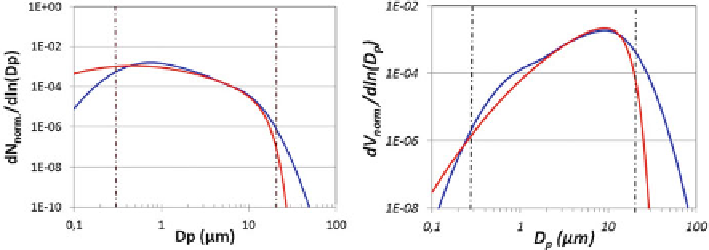Geoscience Reference
In-Depth Information
Fig. 5.5
Relative number (
right
) and volume size distribution computed as a combination of 3
log-normal functions adjusted on field measurements from Sow et al. (
2009
) (number size distri-
bution parameter:
D
1
D
0,73 m;
1
D
1.84;
p
1
D
84 %;
D
2
D
2.32 m;
2
D
1.65;
p
2
D
14 %;
D
3
D
6.51 m;
3
D
1.48;
p
3
D
2 %. Volume size distribution parameters:
D
1
D
1,5 m;
1
D
52 %;
corresponding to the ME4 event in Sow et al. (
2009
)) (
blue line
) and computed with the size
distribution from Kok (
2011a
,
b
) (with
1.79;
p
1
D
8%;
D
2
D
5.1 m;
2
D
1.68;
p
2
D
40 %;
D
3
D
10.4 m;
3
D
1.52;
p
3
D
0.9539 and
C
V
D 12.62). The
dotted lines
correspond to the lower (0.3 m) and higher (20 m) particle size
sampled by Sow et al. (
2009
)
D
, 12;
D
soil
D
3.4 m;
soil
D
3;
C
N
D
predict dust emission rates from various soils, once the input soil properties has been
set to reasonable values, which can be estimated by adjustment of the computed flux
on the measured one.
A different approach has recently been proposed based on an analogy between
the processes of dust emission by sandblasting and the fragmentation of brittle
materials (Kok
2011a
). When a brittle material, such as glass or gypsum, receives
a very large input of energy, it can fragment into a wide range of smaller particle
sizes. Disaggregation of soil aggregates or the release of fine dust particles attached
to sand grains can thus be considered as a similar process. The advantage of this
theory is that the size distribution of the resulting fragments follows a power law and
is thus “scale invariant”. The application of this fragmentation theory to the case of
dust emission by saltating particles requires accounting for the size of the released
indivisible constituents (i.e. the dust particles) and estimating the main parameter of
the power law: the propagation length, œ, that is, the limited length to which side
cracks propagate, that depends on the density of the main cracks (Kok
2011a
). The
production of dust particles of a given size is assumed to be proportional to the
cumulated volume fraction of soil particles smaller than this size, estimated by the
fully dispersed soil size distribution.
Figure
5.5
compares the normalised size distribution in number and volume
obtained assuming dust size distribution as a combination of 3 log-normal functions
(asinAlfaroandGomes(
2001
)) adjusted on field measurements from Sow et al.
(
2009
) (dust event referred to as ME4) and using the “fragmentation” model
from Kok (
2011a
), whose parameters have been adjusted on a series of field
measurements, among which the data from Sow et al. (
2009
) encompass the
largest size range. When considering the size range of the measurements (vertical

Search WWH ::

Custom Search